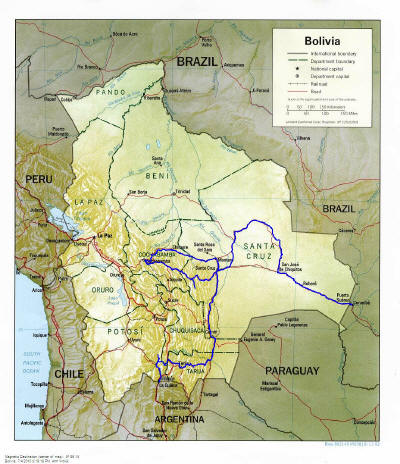 Monday 24 May 2010, Tupiza
Monday 24 May 2010, TupizaSecond Instalment Third Instalment
The border crossing was confusing but eventually we sorted it out and had all the right stamps. The carnet was not required. The Bolivian permit for the car was. We needed diesel and were asked for the permit and after a long explanation in Spanish, which we didn't understand, we paid the Argentinean price for the diesel. We could not find anyone who spoke English to explain it to us. The next time we bought diesel we paid the Bolivian price. The third time we were told the pump did not give the right reading and were asked to pay the Argentinean price which we refused to do. Maybe at the border there is a valid reason to prevent people crossing the border to obtain cheap diesel. However surely that would not apply to us.
The border town on the Bolivian side is very lively. Apparently people cross the border to buy cheap goods and then return. Good business for the Bolivians. The Bolivians are a colourful people with bowler and other hats. Pieter fits right in with his hat. Outside the towns and sometimes inside, the houses are made of adobe with thatch roofs. There are no fences either, wild camping is available everywhere. The roads are being upgraded and tarred. This is good news for the future but it does present the usual problems with dirt roads and having to go on temporary detours. On the whole the roads are good. Unfortunately there are some parts with ribbles that are as bad as that experienced in Sudan. The only difference is the distances are shorter. These patches last for minutes not days!
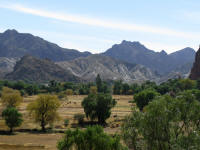
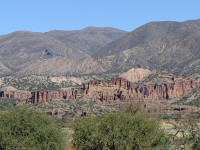 The scenery is fabulous. We missed the sign to Tarija (it is there apparently but quite small) and ended up passing through Tupiza. We asked where a turnoff for Tarija was and were told it was 50K down the road. Naturally we didn't find it. Eventually we turned back because it is too cold to camp and the road goes through mountains and is generally too narrow to get off. We found the turnoff - 20K from Turpiza. By now it was far to late to get to Tarija so we stayed in Turpiza for the night.
The scenery is fabulous. We missed the sign to Tarija (it is there apparently but quite small) and ended up passing through Tupiza. We asked where a turnoff for Tarija was and were told it was 50K down the road. Naturally we didn't find it. Eventually we turned back because it is too cold to camp and the road goes through mountains and is generally too narrow to get off. We found the turnoff - 20K from Turpiza. By now it was far to late to get to Tarija so we stayed in Turpiza for the night.
The town is not very lively but used to foreigners. There is some English spoken and menus are in Spanish and English. Cactus wood is used extensively for furniture and decoration. I found this quite surprising as I had not expected cactus to actually have wood. It is certainly strong enough. Some sections, presumably the younger sections have small gaps. These are used for decoration.
Tuesday 25 to Thursday 27 May 2010, Tarija
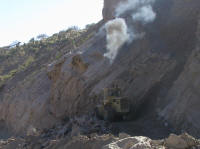
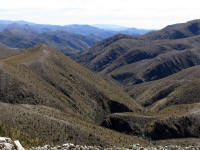 Next morning we had to wait for road workers to finish creating a rock fall and then clear the road. The land is dry with only low plants and grasses. After passing through mountains and hills we finally arrived at a village with a concrete factory and a concrete road. A pleasure to drive on, at least while it lasted. Then we saw a sign to Tarija sooner than expected. What do you believe? A route from a map which may or may not be accurate, or a reasonably new road sign? We went with the sign. The road was not very good. Like all the roads we have traveled on so far, it is in the process of being upgraded. The edges were soft and sometimes eroded. At one place Pieter had to almost stop for another car and then needed the 4x4 capabilities to get started again through the soft sand. On the way down he used first gear because it was so steep with multiple 360 degree turns. We had to go right to the edge sometimes when buses and trucks came through. Amazingly buses actually use the road! Along with trucks pulling 2 trailers. They needed to do multiple point turns to get around the corners. 6 hours later we arrived in Tarija, a distance of 200 kilometres. Needless to say the car was filthy. The dust was so thick that you could barely see there was a number plate at the back. Reading it was impossible. Overnight we collected several notes written in the dust presumably telling us the car was dirty and to get it washed. A good dusting removed quite
a lot.
Next morning we had to wait for road workers to finish creating a rock fall and then clear the road. The land is dry with only low plants and grasses. After passing through mountains and hills we finally arrived at a village with a concrete factory and a concrete road. A pleasure to drive on, at least while it lasted. Then we saw a sign to Tarija sooner than expected. What do you believe? A route from a map which may or may not be accurate, or a reasonably new road sign? We went with the sign. The road was not very good. Like all the roads we have traveled on so far, it is in the process of being upgraded. The edges were soft and sometimes eroded. At one place Pieter had to almost stop for another car and then needed the 4x4 capabilities to get started again through the soft sand. On the way down he used first gear because it was so steep with multiple 360 degree turns. We had to go right to the edge sometimes when buses and trucks came through. Amazingly buses actually use the road! Along with trucks pulling 2 trailers. They needed to do multiple point turns to get around the corners. 6 hours later we arrived in Tarija, a distance of 200 kilometres. Needless to say the car was filthy. The dust was so thick that you could barely see there was a number plate at the back. Reading it was impossible. Overnight we collected several notes written in the dust presumably telling us the car was dirty and to get it washed. A good dusting removed quite
a lot.
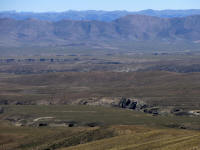
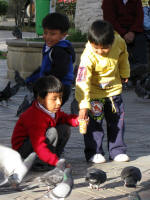
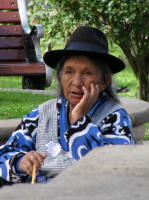
Next morning we found the car had been clamped. Why? There was no sign. The reason? The street where the hotel is had been turned into a pedestrian mall for two days and was filled with street stalls. It was lovely to step out of the hotel straight into the market. Peter had his pocket picked in the crowd! At least it was only a small amount of money and no bank cards. Our time was spent just enjoying the ambience while I nursed my cold.
Friday 28 May 2010, Ville Montes
Another drive through fabulous scenery. Unfortunately there was also a lot of mist. First we had to wait for the road to open though. It opens for an hour at lunch time and then later in the day to allow work on the road to continue. Our normal procedure of starting relatively late worked in our favour. There are tolls on the roads but they are usually less than 10 Bs, not much at all. 8 hours, 250 K. When it began to get dark we started looking for a spot to camp. We were too late. Firstly the road is narrow with few places to pull over and fewer still where we could have put up the tent. Secondly these were already occupied. Trucks and cars were settled in for the night often with a fire going. Trucks usually have somewhere to sleep in relative comfort, but the cars? We pressed on and entered Villa Montes well after dark. The first place we could we asked about hotels and were pointed in the right direction. The hotel is the cheapest we have stayed in with cold shower, TV and no breakfast. It was clean though and the bed comfortable. Because we were out of town the only dinner available was hamburgers. They were very nice actually.
Saturday 28 May to Tuesday 8 June 2010, Santa Cruz
We woke to another misty day and a breakfast of biscuits and fruit. By 11:30 we were hungry and stopped to have roast chicken. This is a standard Bolivian dish. It comprises a quarter (or more) of a large chicken with chips, rice and grilled plantain (a type of banana) with homemade lemonade. A good filling meal. It is so prevalent that in the larger cities there can be 3 or 4 restaurants in each block. The portions are large and eventually we started to share one meal.
The land gradually became flatter as we headed for the warmth and Santa Cruz. The road was tarred the whole way. Lovely. Santa Cruz was warm. After booking into a hotel we had showers and changed into short sleeves.
Once again the ambience is very Mediterranean and lively after sundown. Not warm though. The sun went away and the long sleeves came back out. Some of our meals were taken in one of the restaurants that specialises in ice cream and cakes. The cakes are delicious. The Bolivians certainly know how to make these. The chocolate cake was so rich I could only eat half the portion. Pieter was there to finish it.
We had to wait for Monday to go to the tourist office to ask about camping, Toyota dealers and somewhere to have the fridge fixed. The fridge went in for repair. Now we must wait and see if they can fix it.
Tuesday we went looking for the camp ground. It was in a theme resort, Biocentro Guembe, with an aviary, butterfly house, orchid house and hotel. There were two rules for camping - no car on the premises only in the car park, no outside food allowed. We can't manage without the car and the food would have been quite expensive. What now? The person at reception was extremely helpful and found another place where we could camp. He even printed a map from google earth. Off we went. Once again it was not suitable for us. It was along a rough dirt track quite a few kilometres from town, had no facilities except shade and no-one around. Certainly not the place to leave belongings unattended. Back to town and a cheaper hotel with a larger room and decent shower, more in line with our current financial status and right around the corner from the fridge repair shop.
The restaurant next door provides lunch only. We had the same as the Bolivians eat. It was offal of some sort, possibly pork as the little meat I could see was white and the pieces too large for a chicken. Nicely cooked, interesting and the last time I will have this.
The driving is atrocious. In Argentina it was impossible to decide if the rule was to give way to the right or left, but at least everyone drove slowly. Here it is once again impossible to say. The difference is the speed at which the cars drive. They need good brakes! Traffic lights are only an indication of what to do. If a driver can get away with it they are ignored.
Pieter took the opportunity to find a set of brake pads, have the play in the steering fixed and shock absorbers replaced. We returned to Biocentro Guembe for an outing. Expensive but very well done. The Butterfly cage was wonderful. There were so many it was a pleasure to watch them. The blue and black posed, the others were more interested in flitting around looking for food. The aviary was just as interesting, full of Macaws (parrots) and a Bird of Paradise. Unfortunately only one variety of orchid was in flower. It must be a great sight in season. There are several pools with water cascading from one to the other. The bigger ones have sand in the bottom. I guess people like that. There are also lakes for kayaking.
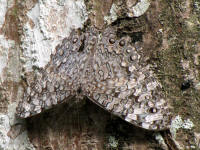
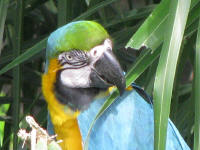
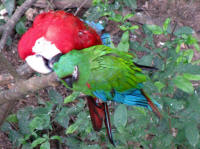
Meantime the fridge is still not ready - manyana, manyana, manyana so we decided to go on a round trip to Cochabamba to get away from the TV (me, Pieter likes the TV but has to have it very loud to hear) and little else to do.
Wednesday 9 to Thursday 10 June 2010, Cuevas
We headed for Samiapata where we expected to find camping. There are 2 places in fact, one costs the same as a double room in a hotel and in neither of them could we camp with the car. There is a basic campground 20 kilometers back at Cuevas. We spent a day cleaning out the car. Everything moveable was taken out and the inside swept and dusted. Then everything was repacked after being dusted and cleaned. This gave 2 good results, one a clean car, inside anyway, and two the opportunity to find a better packing solution for some of the items. The sand ladders are now stored up against the ceiling out of our way. We have used them once in 5 years but we do not want to leave them behind. The weather was reasonable, cool but not too cold.
Friday 11 June 2010, Valle Grande
The pre-Inca ruins of El Fuerte are near Samiapata. Pieter did not go with me but I was lucky enough to meet 6 Israelis with whom I shared a guide making it very interesting. Four different peoples worshipped at the site, each coming from different cardinal points. North - the Chane from the Amazon Valley - 1,500 BC. East - Guarane from the dry Chaca region - 300 AD. South - Mojos from Valle - 800 AD. West - Incas from the Andes - 1450 AD. The sight is aligned for the solstices (east-west) with various motifs. Besides the sun, which we couldn't see as they have banned tourists from walking over the site, there is the Chane puma symbol of power plus the Inca jaguar (power) and snake (fertility). There are seats carved into the rock looking down on the main Inca square, and 5 doors facing 5 other Inca sites. Most information concerns the Inca, little remains of the other groups. The Israelis could speak Spanish and the guide English, Between them I managed to hear all the information given.
Since we were in the area where Che Guevera fought his last battle it was appropriate to go and see the monument at Higuera. The kick off point for the Che Guevera route is Valle Grande. The night was spent next to the bus station and football field.
Saturday 12 June 2010, Epizana
The morning started with the army doing their exercises on the football field. They must have been new recruits because they carried wooden rifles and they were not very co-ordinated. They were also being taught to goose-step which I always associate with a dictatorship.
The tourist Office had no pamphlets showing the Che Guevara route and the significance of each place - not even in Spanish. It didn't have a map of the area either. We were able to get a rudimentary map from a souvenir shop and we could have bought many books on Che, in Spanish. At least the local tourists are catered for to some extent. The road to Higuera was atrocious. Lots of small stones meant driving at 20kph. It didn't take long before we decided we were not big fans of Che and could skip the monument.
We didn't make it to Cochabamba. The road was a mixture of good dirt, poor dirt and previously tarred road. It went over mountains up to 3,600 metres, through clouds and valleys - typical for Bolivia. By late afternoon the sun was often shining directly into Pieter's eyes making it difficult to see through the dusty windscreen. It didn't matter how often it was cleaned, the dust was back within seconds. I didn't think I would ever have to help prevent him from driving on the left hand side of the road but we would have gone off without me watching my side. As it was he did go onto the left hand side of the road a few times.
I am amazed at some of the high places that are cultivated. Farmers truly work hard. It must take quite some time to get to the more remote fields and then manually work the soil. There is irrigation though.
The night was spent in a hotel in a small town. The bed was 3/4 size with a hollow in the middle. We spent the night falling into each other or clinging to the side. There were enough blankets to keep us warm. There were no showers, just toilets without water. But what can you expect for so little? It was a warm bed! Badly needed after a hard days drive. The attached restaurant provided a good cheap meal, beef not chicken.
Sunday 13 June 2010, Cochabamba
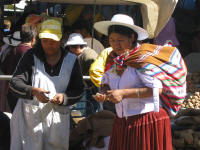 The road directed us through the main market. Everything is for sale. Beds, gas cookers and the usual fruit, veg and clothing. There was lots of time to look as the traffic moved slower than a snail. Once booked in went looking for lunch. There were no coffee shops or restaurants open. Then we found the market with a lively eating section, absolutely packed. We had braaied beef with a large salad and the inevitable chips and rice for very little. Dinner was at Dumbo's where Pieter had an omelette brim full of meat cubes. I was not hungry and only drank fresh lemonade.
The road directed us through the main market. Everything is for sale. Beds, gas cookers and the usual fruit, veg and clothing. There was lots of time to look as the traffic moved slower than a snail. Once booked in went looking for lunch. There were no coffee shops or restaurants open. Then we found the market with a lively eating section, absolutely packed. We had braaied beef with a large salad and the inevitable chips and rice for very little. Dinner was at Dumbo's where Pieter had an omelette brim full of meat cubes. I was not hungry and only drank fresh lemonade.
Monday 14 to Thursday 17 June 2010, Santa Cruz
The main road goes down steeply to sea level, then it is flat and tarred all the way. We made Santa Cruz in 1 day, almost 500 kilometres. Back to our hotel and our room. And warmth, much warmer than last time. This time I went to the Florida Market and had fruit salad for lunch. I should have done this much earlier, it is delicious.
Naturally the fridge was not ready. Manyana guaranteed. Manyana, manyana. We are fed up with waiting. If we could be given a date when it would be ready we could go somewhere else for a while. Sitting in a hotel room is not great. In the end we took it back still not fixed. We now understand that a small part is required and is not available. All this time they have been looking for this part and hoping to find it. Maybe in Brazil. If not then we will take a photo and part number and try to source it ourselves.
Friday 18 to Saturday 19 June 2010, Las Piedras
We decided to go to Brazil via the Jesuit Mission circuit. The missions were set up in the late 17th century by the Jesuits. In return for their labour and conversion to Christianity the Indians were instructed in religion, agriculture and crafts - European style. The churches were built in the 18th century and are mostly made of adobe with carved wooden pillars, large shady verandhas, painted white and decorated in brown.
The first such town is San Javier where the church was closed for renovation.
When we came across a campsite we decided to stop. It is beside a lake and was so nice we stayed 2 days.
Sunday 20 June 2010, San Ignacio
The road to Concepcion continued to be potholed concrete, after that it was bad dirt. The land is flat with many trees, although there are hills near Concepcion. Houses tend to be built on stilts.
The mission at Concepcion (1756) is well renovated. The seats are carved with murals, the walls decorated. The main alter is rather gaudy and the stations of the cross are painted with modern themes- leopards being carried on a stick, trucks and a soldier with a whip and a gun. The bell tower has a corrillion and is made of carved wooden pillars. This was the best we were to see.
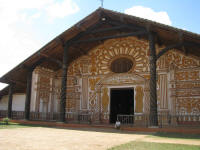
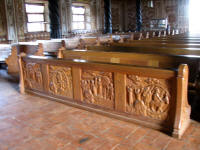
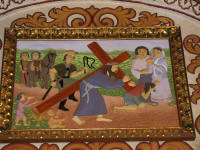
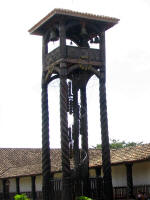
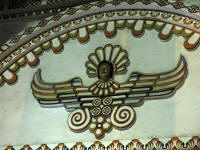
San Ignacio (1748) was closed when we arrived but opened after dark for the Sunday evening service. It was decorated in a similar style to Concepcion except there were many winged gods similar to those at Persepolis in Iran.
Monday 21 June 2010, Robore
Today there were fluffy white clouds in a clear blue sky. The road was good dirt and from San Jose, better concrete all the way to the border. The estancias had large cultivated fields. The flat plain makes it easy to use large machinery. There were also large herds of white Brahmin cattle. The roadside had many shrubs and trees with pink, orange, yellow, blue and purple flowers. The rivers were picturesque. We stopped beside one for lunch and were attacked by mosquitoes. Lunch was very quick!
We visited Santa Ana (1755), San Rafael (1740) and San Jose de Chiquitos (1748). None were open although you could ask to see inside. Having seen Concepcion and San Ignacious I decided not to bother. Communication is always difficult because of my lack of Spanish.
When we filled up with diesel in San Jose our almost flat tyre was pointed out to us. We had it fixed using our rubber strips as Pieter preferred not to have to wrestle with it himself. Unfortunately by evening it was flat again and Pieter had to change the tyres anyway. The person who fixed the tyre obviously was unfamiliar with using the strips.
Tuesday 22 June 2010, to the border
Just before the border we filled up with diesel. There were long queues which we realised later were due to Brazilians crossing the border to buy diesel and then returning to Brazil. The border is very porous - you can read about our border experience in the Brazil page.
| Averages | USD | Next to Brazil | |||
| Cost of diesel per litre | 0.58 | ||||
| Hotels per night | 14.03 | ||||
| Camping per night | 4.27 | ||||
| Total | |||||
| Kilometers traveled | 3,428 | ||||
| Days in country | 29 |